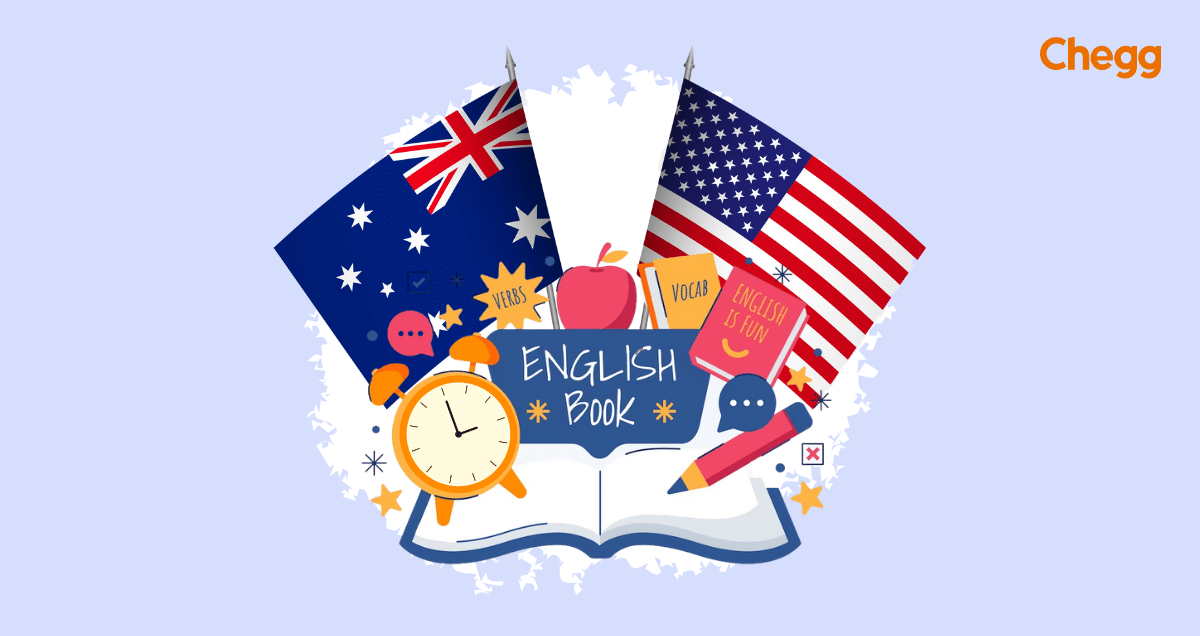Which is Easier TOEFL or IELTS: Make the Right Choice
When it comes to testing your English language proficiency for academic or immigration purposes, two popular examinations often come into consideration: TOEFL and IELTS. Thinking, “which is easier TOEFL or IELTS”? It is important to understand the difference to make a decision. Test of English as a Foreign Language is TOEFL’s full form. The International […] The post Which is Easier TOEFL or IELTS: Make the Right Choice appeared first on Chegg India.

When it comes to testing your English language proficiency for academic or immigration purposes, two popular examinations often come into consideration: TOEFL and IELTS. Thinking, “which is easier TOEFL or IELTS”? It is important to understand the difference to make a decision.
Test of English as a Foreign Language is TOEFL’s full form. The International English Language Testing System is IELTS’ full form. TOEFL and IELTS are tests that check how well you know English. They measure your reading, writing, listening, and speaking abilities.
These tests are administered by different authorities and carry significant weight in assessing your language skills. Both the TOEFL and IELTS tests are widely recognized globally. Universities, colleges, and immigration authorities in English-speaking countries accept both of these tests.
IELTS and TOEFL may appear similar, but they have their unique characteristics. The tests have different structures and require different preparation methods. There are also differences in costs and logistical aspects. Let’s discover about them in this blog
IELTS vs. TOEFL: Key Differences
Choosing the right English language proficiency test can be crucial for many individuals, especially Indian students. Let’s understand the differences between TOEFL and IELTS. This table will help you to understand which is easier TOEFL or IELTS.
| Feature | IELTS | TOEFL |
| Fees | ₹16,250 | ₹14,322 |
| Number of Questions | 40 | 60-80 |
| Exam Duration | 2 hours and 45 | 3 hours and 30 minutes |
| Validity | 2 years | 2 years |
| Mode of Exam | Paper-based, Computer-based, or Online | Online and paper-based |
| Time Taken for Results | Computer-Based – 3-5 days Paper-Based – after 13 days | Approximately 6 days |
| Number of Test Centers in India | More than 10 | 75 |
| Test Administered by | British Council, IDP Education, and Cambridge Assessment English | Educational Testing Service (ETS) |
| Evaluation | Experts and computerized scoring | The Reading and Listening sections are scored by computers. AI and trained examiners score the Speaking and Writing sections. |
| Are there any Breaks? | Listening, Reading, and Writing sections are held together without any breaks. However, the Speaking test can either be scheduled on the same day or within a week before or after the main test date. | Yes, a 10-minute break after the first two sections. |
| How many Universities accept the score? | More than 11,000 | More than 11,500 |
| Examiner Interaction | Face-to-face speaking test | Recorded speaking test |
| Frequency | 48 times a year | 50 times a year |

IELTS vs. TOEFL: Differences in Format
Here, is the table that highlights the differences in the format of the IELTS and TOEFL exams. This will help you understand the variations in sections, duration, and determine which is easier TOEFL or IELTS.
IELTS Exam Pattern
The IELTS exam pattern has four sections: Listening, Reading, Writing and Speaking. Let us take a look at the entire exam pattern and these four sections.
| Section | Duration | Components |
| Listening | 30 minutes | 4 sections, 40 questions |
| Reading | 60 minutes | 3 sections, 40 questions |
| Writing | 60 minutes | 2 tasks |
| Speaking | 11-14 minutes | 3 tasks |
TOEFL Exam Pattern
The TOEFL exam also has four sections. Let us take a look at the exam pattern, questions and the duration of this exam.
| Section | Duration | Components |
| Listening | 41-57 minutes | 28-38 Questions |
| Reading | 54-72 minutes | 30- 40 Questions |
| Writing | 50 minutes | 2 tasks |
| Speaking | 17 minutes | 4 tasks |
Detailed IELTS Pattern
1. Listening section – 4 recordings
The listening test evaluates how well one understands the main ideas and specific facts. It recognizes the speaker’s opinions, attitudes, and purpose.
- Task – Candidates are required to answer questions based on what they hear.
2. The reading section – 3 texts
The IELTS Reading test evaluates the following:
- Reading Speed
- Understanding
- Time Management
The test includes three different passages with related questions. There are separate topics for the IELTS Academic and IELTS General Training exams. The purpose of the IELTS Reading test is to assess various reading skills.
Tasks include:
- Academic reading format
- Academic reading task types
- General training reading format
- General training reading task types
3. The writing section – 2 tasks
The IELTS writing test evaluates different writing skills.
- Task 1 – candidates describe visual information.
- Task 2 – Students write an essay on a given topic.
4. The Speaking Section-
Students appear for a face-to-face interview with an examiner. It is divided into three parts:
- Introduction
- Short speech
- Discussion
- Listening section
- Multiple recordings
- Comprehension questions
2. The reading section
Reading 3-4 passages and answering questions based on the information provided.
3. The speaking section – 4 tasks
Task evaluates candidate’s skills to:
- Express opinions
- Summarize information
- Respond to audio recordings
4. Writing section
- Integrated Task – Candidates read a passage, listen to a lecture, and then write it.
- Independent Task – Candidates write an essay based on their personal experience or opinion.
Types of Questions in TOEFL and IELTS
Both exams test English language proficiency but differ in question formats across the sections: Reading, Writing, Listening, and Speaking. Let’s take a closer look at the question types for each section in both TOEFL and IELTS to understand which is easier TOEFL or IELTS.
TOEFL Question Types
1. Reading Section:
- Multiple Choice Questions
- Insert Text
- Prose Summary
2. Listening Section:
- Multiple Choice Questions
- Lecture with Chart
3. Specking Section
- Independent Speaking – 1 Task
- Integrated Speaking – 3 Tasks
4. Writing Section
- Integrated Writing Task
- Independent Writing Task
IELTS Question Types
1. Listening Section:
- Multiple Choice Questions (MCQs)
- Sentence Completion
- Matching
- Summary Completion
2. Reading Section:
- Multiple Choice
- Sentence Completion
- Matching Information
- Short Answers
- Fill-in-the banks
3. Writing Section:
- Task 1: Candidates describe, summarize, or explain information presented in a graph, chart, table, or diagram.
- Task 2: Candidates write an essay in response to a given prompt, expressing their opinions and supporting them with arguments.
3. Speaking Section:
- Part 1: Candidates answer general questions about themselves, their hobbies, etc.
- Part 2: Candidates are given a topic and speak about it for 2 minutes.
- Part 3: Candidates engage in discussion with the examiner on a related topic.
In summary, both TOEFL and IELTS have their question types that assess different language skills. TOEFL predominantly uses multiple-choice questions.
IELTS incorporates a variety of question types, such as multiple-choice, matching, and sentence completion. Understanding the question formats can help you prepare effectively for either exam and make the right choice based on your strengths and preferences.
Sections in IELTS and TOEFL
When it comes to choosing an English proficiency exam, many students often wonder which is easier TOEFL or IELTS. Both exams are widely accepted and recognized around the world, including in India. In this article, the comparison of the two exams and highlight the key areas of difficulty based on popular consensus is mentioned, to help you make the right choice.
1. IELTS Listening vs. TOEFL Listening
The listening sections of both exams require candidates to comprehend spoken English.
In the IELTS Listening section, which lasts for 30 minutes, you will listen to four different conversations, each followed by ten questions. The recordings are played only once, and you must answer the questions based on your hearing.
The TOEFL Listening section lasts between 41 and 57 minutes and includes audio materials such as conversations, lectures, and discussions. You will then answer around 28 to 39 questions related to the audio content.
2. IELTS Reading vs. TOEFL Reading
In the IELTS Reading section, you will be presented with different texts and passages, ranging from descriptive to argumentative. You will have to answer questions based on the information provided in the texts.
The TOEFL Reading consists of academic passages similar to those you would encounter in a university setting. The questions test your understanding of the passages, requiring you to infer and comprehend complex ideas.
3. IELTS Writing vs. TOEFL Writing
The IELTS Writing section requires you to complete two tasks: Task 1, which involves summarizing, describing, or explaining visual information, and Task 2, which is an essay response to a given prompt.
The TOEFL Writing section also comprises two tasks: an integrated task where you read a passage, listen to a lecture, and then write a response and an independent task where you express your opinion on a given topic.
4. IELTS Speaking vs. TOEFL Speaking
For the IELTS Speaking section, you will have a face-to-face conversation with an examiner. The speaking test has three parts. They are:
- Introduction and Interview
- Short Speech
- Discussion.
The TOEFL and IELTS exams assess your English language skills but differ in their format and approach.
While the TOEFL exam focuses more on academic English, the IELTS exam covers a broader range of contexts. Ultimately, each exam’s difficulty depends on your strengths and weaknesses.
It is recommended to understand the format and requirements of both exams before making a decision which is easier TOEFL or IELTS. Consider factors such as test availability, location, fees, and the format that suits you best.
IELTS vs. TOEFL: Differences in Grading
Remember that the scores required by institutions may vary, so it is essential to check the specific score requirements of your target university or program.
IELTS Scoring
IELTS grades you on a nine-band scale to categorize your level of proficiency – from band score 1 (non-user) to band score 9 (expert).
| IELTS score | Skill level |
| 9 | Expert |
| 8 | Very good |
| 7 | Good |
| 6 | Competent |
| 5 | Modest |
| 4 | Limited |
| 3 | Extremely limited |
| 2 | Intermittent |
| 1 | Non-user |
Source
Each test receives a score. These individual scores are averaged and rounded to the nearest half-band to determine the overall band score.
Let’s take an example. Suppose the average score for the listening, reading, writing, and speaking sections is 5.75. Then the overall band score will be rounded to 6.0.
TOEFL Scoring
TOEFL evaluates your reading, writing, listening, and speaking skills in one test.
| Section | TOEFL score | English language skill level |
| Listening | 22 – 30 | Advanced |
| 17 – 21 | High-intermediate | |
| 9 – 16 | Low-intermediate | |
| 0 – 8 | Below low-intermediate | |
| Reading | 24 – 30 | Advanced |
| 18 – 23 | High-Intermediate | |
| 4 – 17 | Low-Intermediate | |
| 0 – 3 | Below Low-Intermediate | |
| Speaking | 25 – 30 | Advanced |
| 20 – 24 | High-intermediate | |
| 16 – 19 | Low-intermediate | |
| 10 – 15 | Basic | |
| 0 – 9 | Below Basic | |
| Writing | 24 – 30 | Advanced |
| 17 – 23 | High-intermediate | |
| 13 – 16 | Low-intermediate | |
| 7 – 12 | Basic | |
| 0 – 6 | Below Basic |
In TOEFL, the total score is calculated by adding up these individual scores.
IELTS Score vs. TOEFL Score
TOEFL vs. IELTS Score: To give you a clearer picture, here is a table comparing IELTS scores with their corresponding TOEFL scores:
| IELTS Score | TOEFL Score |
| 9 | 118-120 |
| 8.5 | 115-117 |
| 8 | 110-114 |
| 7.5 | 102-109 |
| 7 | 94-101 |
| 6.5 | 79-93 |
| 6 | 60-78 |
| 5.5 | 46-59 |
| 5 | 35-45 |
| 4.5 | 32-34 |
| 0-4 | 0-31 |
IELTS vs. TOEFL: Which is Easier?
TOEFL and IELTS are two popular English language proficiency tests that are widely accepted by universities, colleges, and immigration authorities around the world.
Are you wondering which is easier TOEFL or IELTS for Indian Students? Well, you are not alone. The article has made this easy for you.
1. TOEFL or IELTS for Indian Students
Both TOEFL and IELTS are recognized and accepted by universities in India. However, the exam you choose depends upon your preferred institution. Some universities may prefer one test over the other, so check the admission criteria of your desired university or program.
2. Is IELTS Difficult?
The difficulty level of IELTS varies from student to student. As stated earlier, the IELTS exam tests your English language skills in four sections. Each section has its challenges. However, with proper preparation and practice, you can excel in all. The difficulty level of IELTS varies from student to student.
Taking mock tests, studying vocabulary, and familiarizing yourself with the test format can help you overcome any difficulties.
3. What is a Good Score in TOEFL?
TOEFL scores are measured on a scale of 0 to 120. Different universities and programs have specific score requirements, so checking the minimum score needed for your desired institution is crucial.
An 80 or above score is usually considered a good score for institutions. However, top universities may require higher scores, typically ranging from 90 to 100 or more.
4. IELTS Cut-OFF
Top universities such as Harvard and Stanford usually have an IELTS cut-off score of 7 or 8. The IELTS test is scored on a scale of 1 to 9. Universities that accept IELTS scores set specific cut-off scores for overall and individual sections to assess a candidate’s English proficiency. The IELTS cut-off is the required IELTS score set by the university. It can vary among universities and the different programs they offer.
5. IELTS vs. TOEFL Difficulty
To answer which is easier TOEFL or IELTS both TOEFL and IELTS have their unique challenges. TOEFL is known for its academic approach. It focuses on American English and emphasizes language used in university settings. On the other hand, IELTS covers both British and American English and has a more general approach. The choice between the two exams depends on your familiarity with the respective accents and your preferences.
Making the Right Choice Between TOEFL and IELTS
Both exams are widely accepted and recognized by universities and institutions around the world.
Familiarize yourself with the test format, practice sample questions, and seek guidance if needed. Remember, it doesn’t matter which is easier TOEFL or IELTS, both TOEFL and IELTS require consistent effort and dedication to achieve a good score.
Choosing between TOEFL and IELTS depends on your personal preferences, strengths, and goals. Consider the requirements of the institutions you are applying to, the countries where you plan to study or work, and your comfort level with different English language styles. With proper preparation and a clear understanding of your needs, you can make an informed choice and excel in either exam.
Good luck on your English language journey!
Frequently Asked Questions (FAQ’s)
Choosing between IELTS and TOEFL depends on your specific requirements and preferences. Both tests assess your English language skills, but there are some differences. If you prefer American English and multiple-choice questions, TOEFL might be a better fit. If you are comfortable with British English and prefer a variety of question formats, IELTS could be the right choice.
The difficulty level of TOEFL varies for individuals. However, many Indian students find TOEFL challenging due to its unique format and emphasis on academic English. It requires strong reading and listening skills and effective time management. With thorough preparation and practice, Indian students can overcome the challenges and achieve success in the TOEFL.
The prestige of TOEFL or IELTS depends on the specific context. TOEFL is widely recognized and accepted by universities in the United States (US). IELTS is commonly accepted in countries like the United Kingdom, Australia, and Canada. Both tests hold equal importance and are respected in their respective regions.
The level of difficulty in IELTS can vary for Indian students based on their proficiency in English and familiarity with the test format. However, IELTS is designed to test your English language skills fully. Indian students who have a good command of English and dedicate sufficient time to prepare for the test can achieve favorable results in the IELTS.
Other Related Reads
The post Which is Easier TOEFL or IELTS: Make the Right Choice appeared first on Chegg India.



























